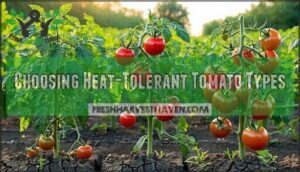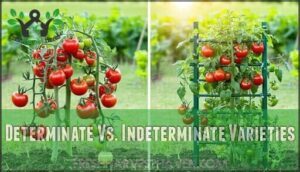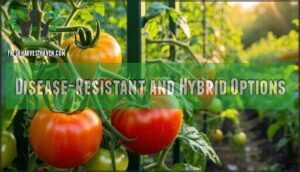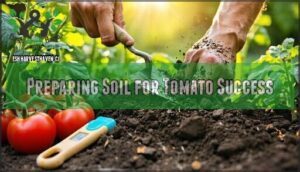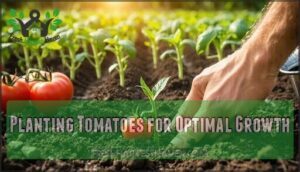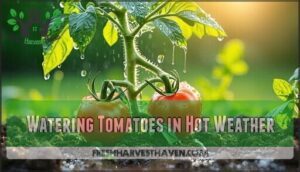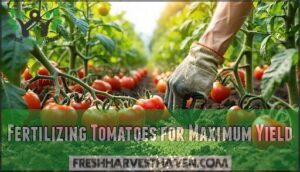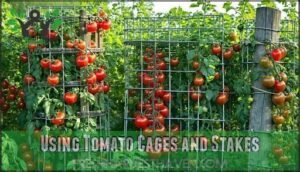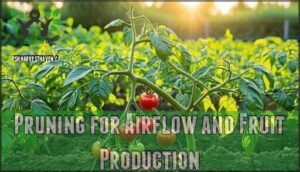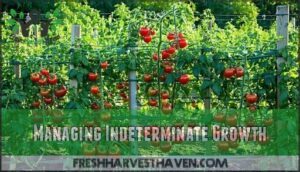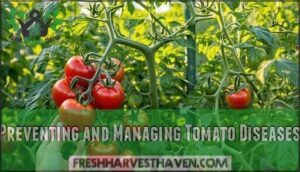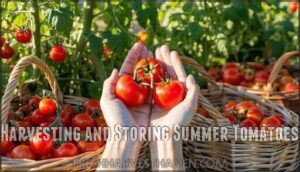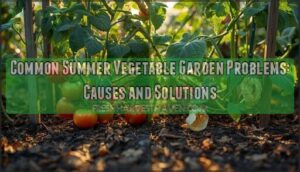This site is supported by our readers. We may earn a commission, at no cost to you, if you purchase through links.
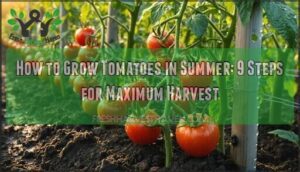
Water deeply and consistently, avoiding the leaves to prevent disease. Use shade cloth during extreme heat waves when temperatures climb above 95°F.
Install sturdy cages or stakes early, then prune suckers between main stems to boost fruit production. Regular pruning improves air circulation and directs energy toward developing those juicy tomatoes you’re after.
Getting your fertilizer timing down makes all the difference.
Table Of Contents
- Key Takeaways
- Best Tomato Varieties for Summer
- Preparing Soil for Tomato Success
- Planting Tomatoes for Optimal Growth
- Providing Sunlight and Managing Heat
- Watering Tomatoes in Hot Weather
- Fertilizing Tomatoes for Maximum Yield
- Supporting and Pruning Tomato Plants
- Preventing and Managing Tomato Diseases
- Harvesting and Storing Summer Tomatoes
- Frequently Asked Questions (FAQs)
- Can tomatoes be grown in the summer?
- Should I water tomatoes every day in hot weather?
- What does Epsom salt do to tomatoes?
- What do coffee grounds do for tomato plants?
- Should you water tomatoes every day in hot weather?
- Can tomatoes grow in 90 degree weather?
- What is the secret to growing tomatoes?
- Can you grow tomatoes in a summer garden?
- How to grow tomatoes?
- Can tomatoes grow in hot weather?
- Conclusion
Key Takeaways
- Choose heat-tolerant varieties like Cherokee Purple or Phoenix that’ll keep producing fruit even when temperatures climb above 90°F, since regular varieties stop setting fruit in extreme heat.
- Water deeply but less frequently – soak the soil 6-8 inches deep once or twice weekly rather than daily light watering, which creates weak, shallow roots and stressed plants.
- Use shade cloth when it gets brutal – install 30-50% shade cloth during heat waves above 95°F to protect plants while still allowing enough light for photosynthesis and growth.
- Plant early and harvest smart – get your tomatoes in the ground when soil hits 60°F so they’re established before peak summer, then pick fruit at the first blush of color when temperatures soar.
Best Tomato Varieties for Summer
You’ll need to pick the right tomato varieties to handle summer’s blazing heat and humidity without sacrificing your harvest.
Heat-tolerant types like Cherokee Purple, Stupice, and Phoenix can keep producing fruit even when temperatures soar above 90°F, while disease-resistant hybrids protect your plants from common summer ailments.
Choosing Heat-Tolerant Tomato Types
When summer temperatures soar, you’ll want heat-tolerant tomato varieties that won’t buckle under pressure. These champions resist blossom drop while maintaining flavor retention and drought tolerance.
Here are three top performers for choosing tomato varieties:
- ‘Florida 91’ – Delivers consistent fruit set with excellent sunscald resistance
- ‘Heatmaster’ – Shows strong heat set capabilities and prevents fruit cracking
- ‘Solar Fire’ – Thrives in extreme heat with exceptional drought tolerance
Consider exploring other heat tolerant options for your garden.
Determinate Vs. Indeterminate Varieties
Your tomato plant selection starts with understanding growth habit. Determinate types reach 1-5 feet, producing fruit clusters between each leaf before stopping growth. These compact plants need minimal staking methods and ripen fruit simultaneously.
Indeterminate types grow 5-8 feet tall, producing clusters between every third leaf throughout the season. They require sturdy staking and continuous pruning needs, but offer extended harvests.
Disease-Resistant and Hybrid Options
Hybrid tomato types pack serious advantages for summer growing. These varieties combine disease resistance with hybrid vigor, giving you plants that can handle summer’s challenges better than traditional options.
What makes hybrids worth growing? Four key advantages stand out:
- VFN resistance – Protection against Verticillium wilt, Fusarium wilt, and nematodes
- Blight tolerance – Built-in defenses against early and late blight outbreaks
- Heat-tolerant performance – Varieties like ‘Iron Lady’ and ‘Big Beef’ maintain fruit set during hot spells
- Reduced chemical inputs – Disease resistance means fewer fungicide applications needed
Modern seed selection focuses on grafting tomatoes onto disease-resistant rootstock, though this isn’t genetic modification—it’s traditional breeding techniques creating stronger plants. These tomatoes are often bred for improved disease resistance, allowing them to thrive even when infection is present.
Heirloom Varieties for Unique Flavors
While heirloom varieties require more attention during tomato cultivation, they reward you with exquisite heirloom flavors that hybrids can’t match. Cherokee Purples and Brandywines offer rich, complex tastes perfect for variety selection.
These heritage tomatoes face growing challenges like disease susceptibility, but heat-tolerant heirloom varieties like Phoenix and Stupice thrive in summer heat.
Seed saving lets you preserve favorites for next season’s outdoor tomato growing adventures.
Preparing Soil for Tomato Success
Your soil is the foundation of your tomato harvest, and getting it right from the start will save you headaches later. You’ll want to test your soil’s pH and work in 2-3 inches of compost to create the loose, well-draining environment that tomatoes need to thrive in summer heat.
Improving Clay or Sandy Soils
Bad soil will crush your gardening plans before a storm even has the chance.
Clay that won’t drain and sandy soil that dries out in hours—both spell trouble unless you fix them first.
- Amending clay soil: Work 2-3 inches of coarse sand and compost into the top 6-9 inches to improve drainage and break up compacted areas
- Improving sandy soil: Mix in plenty of organic matter like aged manure or leaf mold to boost water retention and nutrient-rich soil development
- Soil pH balance: Test your soil first—most plants thrive in slightly acidic conditions between 6.0-6.8 for best nutrient uptake
Adding Organic Matter and Compost
Before planting, you’ll want to enrich your soil with organic matter and compost. These soil amendments boost nutrient cycling and dramatically improve soil health. Mix 2-3 inches of compost into the top 6-9 inches of soil for best results.
| Organic Material | Compost Benefits | Application Rate |
|---|---|---|
| Well-aged compost | Improves drainage, adds nutrients | 2-3 inches mixed in |
| Rotted cow manure | High nitrogen, slow release | 1-2 inches worked in |
| Leaf mold | Enhances soil structure | 2-4 inches incorporated |
Raised Beds for Better Drainage
Raised beds solve drainage problems that plague clay and sandy soils. You’ll want to build them four to six inches high using cedar boards or composite materials. This soil elevation creates better drainage systems while improving soil health.
- Choose rot-resistant raised bed materials like cedar or metal
- Guarantee proper soil preparation for tomatoes with good drainage
- Install water conservation features like drip irrigation
- Fill with the best soil for tomatoes—compost-rich mix
Your tomatoes’ roots will thank you.
Planting Tomatoes for Optimal Growth
You’ll plant your tomato seedlings deeper than most other plants, burying the lower stem up to the first set of true leaves to encourage strong root development.
Space your plants about three feet apart, remove the bottom leaves, and use a starter fertilizer solution to give them the best foundation for summer growth.
Starting From Seeds Vs. Seedlings
When starting tomato plants, you’ll face the classic gardener’s dilemma: seeds or seedlings. Seeds offer better seed selection and cost savings, but require proper germination tips like warmth and consistent moisture. Seedlings provide a head start but limit variety choices.
Seeds do take 6-8 weeks longer to get going, but here’s the trade-off: they usually grow tougher, deeper root systems than store-bought seedlings.
For summer success, seedlings win the race against heat, giving you transplant methods that work when time matters most.
Proper Plant Spacing and Depth
Why crowd your tomatoes when they need room to breathe? Space your plants three feet apart for ideal air circulation and sunlight penetration.
Plant deeply, burying two-thirds of the stem after removing lower leaves. This deep soil depth encourages vigorous root development and sturdier stems.
Proper plant density prevents disease while maximizing your tomato cultivation success through proven gardening techniques.
Using Starter Solutions at Planting
Give your seedlings the best start with a starter solution at planting time. This diluted fertilizer mixture provides essential plant nutrition during those critical first weeks when roots are establishing.
Mix one tablespoon of balanced fertilizer in a gallon of water, then pour around each newly planted tomato. This growth booster ensures proper soil enrichment and aids healthy seedling care through early tomato cultivation stages.
Removing Lower Leaves Before Planting
After applying your starter solution, you’ll want to strip away the lower leaves from your tomato plants before planting.
This leaf removal benefits your plants by preventing soil-borne diseases and encouraging stronger root development. Remove leaves from the bottom third of the stem—you’ll bury this portion for better stem burial and soil coverage, creating a sturdy root system that bolsters healthy growth.
Providing Sunlight and Managing Heat
You’ll need to balance your tomatoes’ love for sunshine with protection from scorching summer heat, since they require over six hours of direct sunlight daily but can stop setting fruit when temperatures climb above 95°F.
Plant early in the season and consider shade cloth during heat waves to keep your plants productive when the mercury rises.
Ensuring Full Sun Exposure
Your tomato plants need full sun to grow their best. These warm-season crops depend on strong light for photosynthesis, and getting enough sun makes or breaks your outdoor garden.
Here’s what matters for sunlight:
- Pick spots that get 6-8 hours of direct sun each day
- Keep an eye on soil temperature – it needs to stay consistently warm
- Think about your local climate when placing plants
- Skip areas with morning shade that slow down warming
- Put taller plants where they won’t block your tomatoes
Get the sunlight right, and you’ll see better fruit and healthier plants overall.
Using Shade Cloth in Extreme Heat
When temperatures soar above 95°F, providing shade becomes your tomato plants’ lifeline. Install 30-50% shade cloth over your summer canopy to reduce heat stress while maintaining growth.
These shade fabric options filter harsh sunlight without blocking essential light. Position cloth 2-3 feet above plants for airflow.
Even heat-tolerant tomato varieties benefit from this protective barrier during extreme weather conditions.
Managing Temperature for Fruit Set
While shade cloth protects plants, temperature control matters most for fruit set. Your tomatoes need that sweet spot between 65-80°F during the day. Heat stress above 95°F kills pollen and stops fruit formation completely. These warm-season crops can handle heat, but their reproductive system can’t.
- Nighttime temperatures above 75°F cause blossom drop
- Heat-tolerant tomato varieties maintain better fruit set during stress
- Thermal tolerance varies between climate zones and cultivars
- Frost risk isn’t your summer worry—excessive heat is
Early Planting to Beat Summer Heat
Smart gardeners know timing beats the heat every summer. Plant your early tomatoes when soil temperature reaches 60°F, usually 2-3 weeks before your last frost risk passes. This climate adaptation strategy gives heat-tolerant tomato varieties time to establish strong roots before summer’s scorching temperatures arrive.
Early planting tips include choosing warm-season crops that mature quickly, allowing proper crop rotation, and avoiding summer sowing during peak heat periods.
Watering Tomatoes in Hot Weather
When summer heat peaks, your tomatoes need water more than ever, but you’ll want to water smart to avoid common mistakes that can kill your plants.
The key is soaking the soil 6 to 8 inches deep once or twice a week rather than light, daily watering that creates shallow roots and stressed plants.
Deep and Consistent Watering Techniques
Here’s what I learned the hard way about watering tomatoes: those daily sprinkles we all do? They’re actually working against us.
What tomatoes really want is deep, infrequent watering that forces their roots to dig down and get strong.
Soak the soil 6-8 inches deep once weekly using drip irrigation or soaker hoses. This water management approach encourages roots to grow deeper, improving water retention and soil moisture stability throughout summer’s heat.
Avoiding Overwatering and Water Stress
Getting water balance right prevents both overwatering and drought stress in your tomato plants. Check soil moisture by inserting your finger two inches deep—if it’s dry, it’s watering time.
Proper irrigation management and mulching improve water retention while supporting your plants’ drought tolerance. Smart water conservation keeps roots healthy without drowning them.
Best Times of Day to Water
Morning watering wins the timing game. Water plants early, between 6–8 AM, so they absorb moisture before the heat hits. This prevents stress and reduces disease risk. Avoid evening hydration—wet leaves overnight invite fungal problems.
If you use drip irrigation, morning watering schedules work perfectly. Check soil moisture first; soggy ground means skip today. Water management isn’t rocket science, just good timing.
Fertilizing Tomatoes for Maximum Yield
You’ll nee
Choosing The Right Tomato Fertilizer
Balanced fertilizer usually works best for tomatoes, with equal parts nitrogen, phosphorus, and potassium. Look for formulas like 10-10-10 or organic options such as compost and seaweed plant food.
Before you add any fertilizer, test your soil to see what nutrients it actually needs and check the pH.
Adding organic matter like compost feeds your soil slowly over time, but if your tomatoes need a quick boost, synthetic fertilizers work fast.
Timing and Frequency of Applications
Once you’ve chosen the right fertilizer, timing becomes everything. Apply fertilizer every two to three weeks during the growing season, following watering intervals for ideal uptake.
Start fertilizing two weeks after transplanting, then maintain consistent application rates throughout summer.
Monitor soil conditions and adjust schedules based on plant growth and fruit development for peak harvest success.
Signs of Nutrient Deficiencies
Watch for yellowing leaves creeping up from the bottom—that’s nitrogen deficiency talking. Purple leaf undersides signal phosphorus problems, while brown leaf edges mean potassium’s running low.
A quick soil test reveals what your tomato plant care routine is missing, helping you choose the right fertilizer options for nutrient-rich soil.
Supporting and Pruning Tomato Plants
You’ll need sturdy bracing structures like cages or stakes to keep your tomato plants upright and productive throughout the summer heat.
Regular pruning removes excess growth, improves air circulation, and directs the plant’s energy toward producing more fruit instead of unnecessary leaves.
Using Tomato Cages and Stakes
You’ll need sturdy bracing systems before your tomato plants get too heavy. Wire tomato cages work well for determinate varieties, while wooden stakes handle indeterminate types better.
Install bracing at planting time to avoid damaging roots later. Space stakes three feet apart, matching your plant spacing. Choose galvanized materials that won’t rust through the season.
Pruning for Airflow and Fruit Production
Through strategic pruning techniques, you’ll boost air circulation and optimize fruit production. Remove suckers between main stems and branches, plus trim lower leaves touching soil.
This leaf trimming prevents disease while directing energy toward developing fruit. Space cuts properly to maintain plant spacing benefits.
Regular stem removal of damaged branches keeps tomato plants healthy throughout your growing season.
Managing Indeterminate Growth
Indeterminate tomatoes keep growing like teenagers who won’t stop eating. You’ll need to stay on top of pruning techniques and growth regulation. Remove suckers weekly, train stems upward, and manage leaf density for airflow. Unlike determinate bush varieties, these climbers need constant attention.
Managing your indeterminate giants:
- Remove suckers between main stem and branches to focus energy on fruit
- Train stems upward using trellis systems and stem training methods
- Trim lower leaves touching soil to prevent disease spread
- Top plants at 6-7 feet to concentrate energy on ripening existing fruit
Preventing and Managing Tomato Diseases
You’ll face common tomato diseases like blight, wilt, and blossom-end rot during summer’s heat and humidity.
Proper mulching, watering, and plant spacing can prevent most problems. When diseases do strike, quick identification and treatment will save your harvest and keep your plants producing through the season.
Mulching to Reduce Disease Spread
Around your tomato plants, spread a 2-3 inch layer of organic mulch materials like straw or shredded leaves. This barrier blocks soil temperature fluctuations while providing moisture retention and weed suppression.
Quality mulch prevents soilborne diseases from splashing onto leaves during watering. Avoid using compost as mulch since it can harbor pathogens that cause tomato diseases.
Identifying and Treating Common Pests
Common tomato pests can wreak havoc on your summer harvest if you don’t catch them early. Look for aphids clustering on stems, tomato hornworms munching leaves, whiteflies on undersides, and spider mites creating fine webbing.
Natural predators like ladybugs help with aphid control, while hand-picking works great for hornworms. Regular inspection prevents these pests from becoming major problems.
Dealing With Blossom-End Rot
Blossom-end rot appears as dark, sunken spots on tomato bottoms, signaling calcium deficiency issues. This frustrating problem stems from inconsistent watering practices and improper soil pH levels.
- Test soil pH and apply liming application if below 6.0
- Maintain consistent watering schedules to prevent calcium uptake issues
- Mulch around plants to stabilize soil moisture levels
- Apply calcium-rich fertilizers during early detection stages
- Monitor watering and fertilization of tomatoes regularly for disease prevention in tomatoes
Crop Rotation and Sanitation Tips
Want to keep your tomatoes healthy? Prevention beats treatment every time with smart rotation. Move your tomatoes to fresh soil each year—this simple trick starves soilborne diseases that love to stick around and cause trouble next season.
Clean tools between plants to prevent spreading blight and other tomato diseases. Remove garden debris and control weeds that harbor pests.
Follow these basics and you’ll set your plants up for success all season long.
Harvesting and Storing Summer Tomatoes
You’ll know it’s time to harvest when your tomatoes show their first blush of color, especially when temperatures stay above 95°F, since extreme heat can prevent proper ripening on the vine.
Proper harvesting and storage techniques will help you enjoy fresh, flavorful tomatoes for weeks after picking, even when summer heat makes growing conditions challenging.
When and How to Harvest Ripe Fruit
When your tomatoes show their first blush of color, you’ve hit the sweet spot for harvesting time. Pick tomatoes at the "breaker stage" when they’re just turning from green to pink—they’ll continue ripening off the vine while developing better flavor.
Gently twist and pull ripe tomatoes, handling them like delicate treasures to avoid bruising. Check plants daily during peak season to extend harvest and catch fruits at their flavor indicators peak.
Handling Tomatoes in Extreme Heat
When temperatures soar above 95°F, you’ll face ripening challenges that demand quick action. Pick tomatoes showing hints of color rather than waiting for full ripeness—extreme heat destroys flavor and stops proper development.
Early picking preserves taste while protecting fruit from sun damage. Use shade cloth and mulch for sun protection, helping heat-tolerant tomato varieties survive scorching days. Consistent watering prevents heat stress.
Storing Tomatoes for Freshness and Flavor
Perfect harvesting of ripe tomatoes deserves proper storage to extend shelf life.
Keep ripening stages at room temperature between 55-70°F with moderate humidity control. Avoid storing with ethylene gas producers like bananas, which speed up ripening.
Your tomato harvest will stay fresh longer when kept stem-side down away from direct sunlight.
Frequently Asked Questions (FAQs)
Can tomatoes be grown in the summer?
Yes, you can absolutely grow tomatoes in summer! They’re actually warm-season crops that thrive in hot weather, though extreme heat above 95°F can affect fruit ripening and set.
Should I water tomatoes every day in hot weather?
Like a heat-stressed parent, your tomatoes get desperate when temperatures soar.
When summer heat soars above 90°F, your tomatoes become as desperate for relief as any overwhelmed caregiver
When temperatures reach the 90s, you can expect to water them daily, but check soil first—stick your finger deep down to test.
What does Epsom salt do to tomatoes?
Epsom salt provides magnesium that helps with seed starting, growing strong cell walls, and improving plant uptake of nitrogen, phosphorus, and sulfur.
If your tomato plant is magnesium deficient, you’ll notice yellow leaves with green mottling .
What do coffee grounds do for tomato plants?
Coffee lovers rejoice: coffee grounds are packed with nutrients that tomato plants love, like nitrogen, potassium, and phosphorus.
You’ll boost soil health and potentially deter pests, but compost them first for best results.
Should you water tomatoes every day in hot weather?
Daily watering isn’t always necessary in hot weather. Deep soaking is better than a little water every day.
Check soil moisture several inches down—you’ll need daily watering only if it’s dry.
Can tomatoes grow in 90 degree weather?
Your tomatoes can survive 90-degree weather, but they won’t set fruit well. When temperatures hit 85°F to 90°F, flower pollination fails and fruit production stalls.
Pick existing tomatoes early and wait for cooler days.
What is the secret to growing tomatoes?
Choose the right variety for your climate, plant deep with staking, maintain consistent watering, and provide full sun exposure. Proper spacing prevents disease spread.
Can you grow tomatoes in a summer garden?
Like planting seeds in a greenhouse, you can absolutely grow tomatoes in summer gardens.
Choose heat-tolerant varieties, provide consistent watering, and pick fruit early when temperatures exceed 95°F to prevent ripening issues.
How to grow tomatoes?
Start with quality seedlings, plant them deep in rich soil with full sun exposure.
Space them three feet apart, water deeply weekly, and stake or cage for structure as they grow.
Can tomatoes grow in hot weather?
My Phoenix tomatoes survived last August’s brutal 105°F streak. Yes, tomatoes can grow in hot weather, but they need heat-tolerant varieties, shade cloth, consistent watering, and proper timing to thrive.
Conclusion
Successfully growing tomatoes in summer requires dedication, but the payoff is worth every effort. You’ve learned how to grow tomatoes in summer through careful variety selection, proper soil preparation, and strategic watering techniques.
The truth is, your tomatoes respond to steady attention far better than bursts of intensive care followed by neglect.
When you stick to these methods consistently, you’ll be amazed at the quality and quantity of fruit your plants produce.
Start planning next year’s garden while enjoying this season’s bounty.
- https://irisheyesgardenseeds.com/tomatoes-vital-statistics/
- https://fieldreport.caes.uga.edu/publications/B1271/georgia-homegrown-tomatoes/
- https://agrilifeextension.tamu.edu/wp-content/uploads/2025/04/growing-tomatoes-successfully-on-the-texas-high-plains.pdf
- https://yardandgarden.extension.iastate.edu/faq/what-proper-spacing-when-planting-tomatoes-garden
- https://www.gardeningknowhow.com/edible/vegetables/tomato/spacing-tomato-plants.htm

